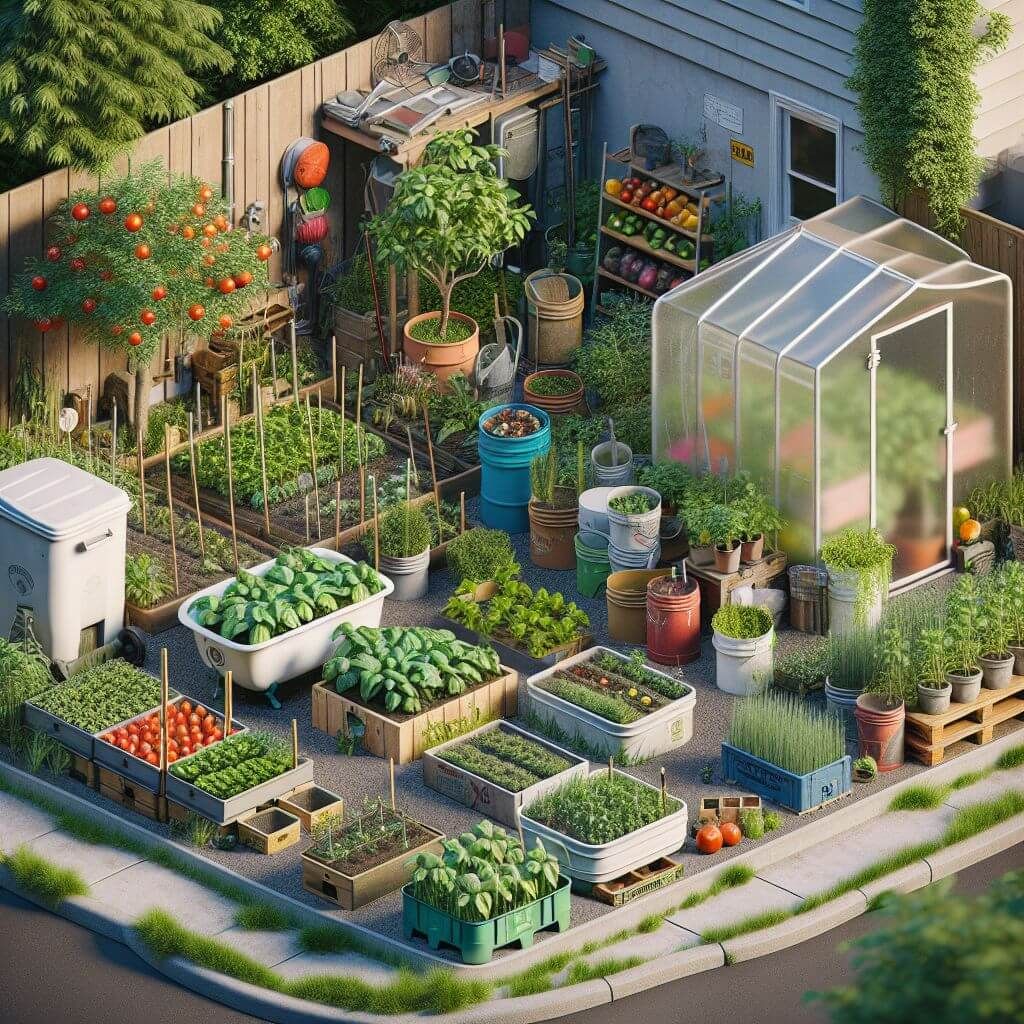
Article-at-a-Glance
Discover the essentials of urban homesteading to transform your city space into a green oasis.
Learn how to select the right crops for your urban environment and maximize your yields.
Embrace sustainable practices with DIY composting and efficient water usage.
Understand the impact of urban homesteading on local food systems and community well-being.
Get equipped with the best tools and heirloom seeds to ensure a successful urban garden.
Embark on Your Urban Homesteading Journey
Urban homesteading is more than a hobby; it’s a transformative lifestyle that brings sustainability right to your doorstep. Whether you have a balcony, a rooftop, or just a windowsill, you can contribute to a greener planet and cultivate your own food. It’s all about making the most of what you have and being resourceful.
Why Urban Homesteading Matters
Think about it: food travels miles to reach our plates, consuming energy and resources along the way. By growing your own, you’re slashing that distance to mere feet. Besides that, you’re ensuring that what you eat is fresh, organic, and packed with nutrients. Most importantly, you’re taking a stand against the unsustainable practices of mass agriculture.
Small Spaces, Big Yields: What You Can Achieve
Don’t underestimate the power of a small space. With the right approach, you can grow a surprising amount of food. From leafy greens to herbs and even some fruits, your urban homestead can be as diverse as any traditional garden. Because every inch counts, vertical gardening and container planting become your best friends in maximizing yield.
Jumpstarting Your Urban Garden
Starting an urban garden is thrilling, but where do you begin? First, assess your space for sunlight and consider what you love to eat. There’s no point in growing radishes if no one in your household will eat them. Then, it’s time to get your hands dirty—literally.
Choosing Your Crops Wisely
When selecting crops, think about the climate, the space you have available, and how much care each plant needs. Here’s a simple guide to get you started: for more detailed information, consider reading these 9 Tips for Growing Your Own Food in a City.
Leafy Greens: Spinach, lettuce, and kale are perfect for beginners and can be harvested multiple times.
Herbs: Basil, cilantro, and parsley can thrive on a sunny windowsill and add fresh flavors to your meals.
Root Vegetables: Radishes and carrots require deeper containers but are otherwise easy to grow and very rewarding.
Maximizing Limited Space
Space is a premium in the city, so we’ve got to be smart about it. Use hanging baskets, stackable planters, and trellises to take advantage of vertical space. Containers on wheels can be moved to catch the sun, and window boxes can turn a sill into a mini-garden. Remember, upward growth means more room for plants!
DIY Composting: Turning Scraps into Soil
Composting is like alchemy for the urban homesteader. By recycling your kitchen scraps, you create rich soil that’s full of life. Here’s how to start a simple compost bin:
Choose a container with a lid to keep pests out and odors in.
Mix green waste (like vegetable peels) with brown waste (like cardboard) for a balanced compost.
Keep the mix moist and turn it every week to speed up decomposition.
Before you know it, you’ll have a supply of homemade compost to nourish your plants.
Water Wisdom for City Growers
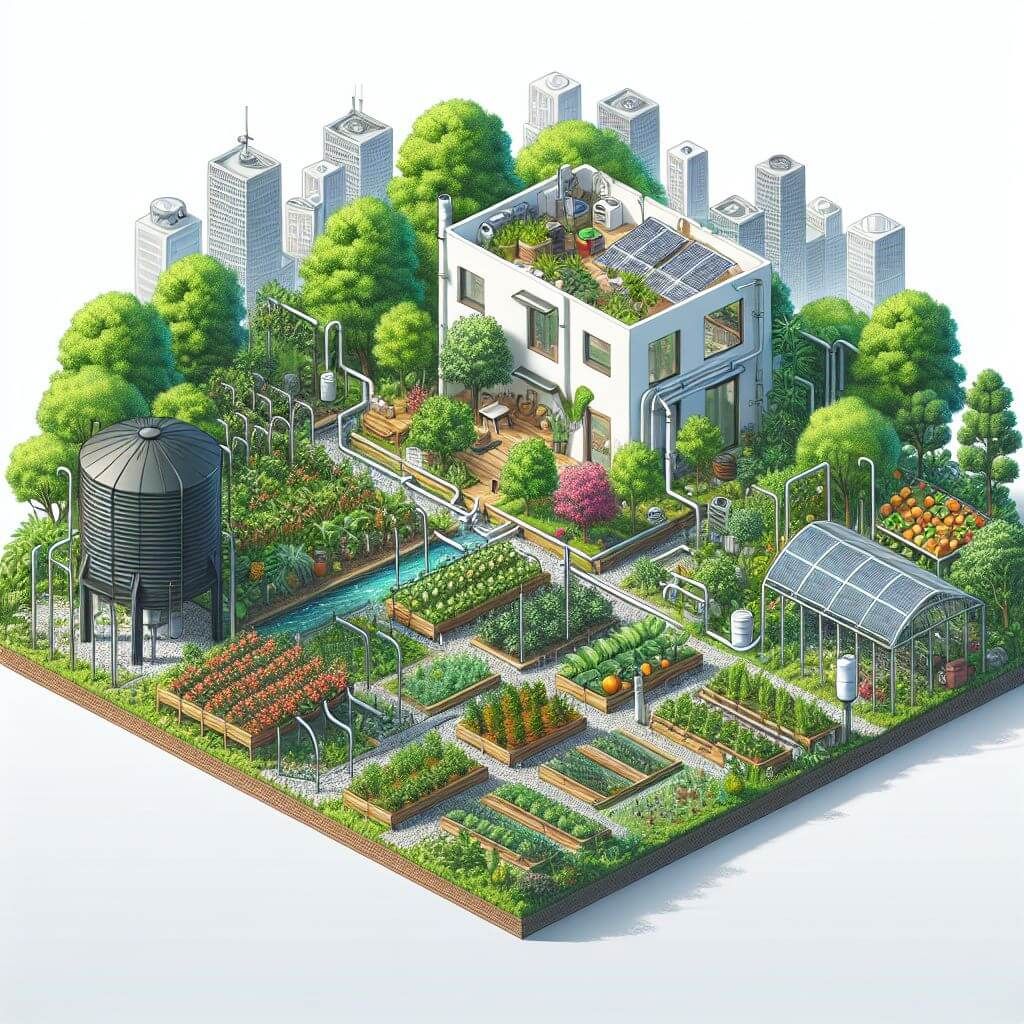
Water is precious, especially in urban areas. Collecting rainwater is a smart move—it’s free, and plants love it. Just set up a barrel under your downspout, and let nature do the rest. Plus, using a watering can instead of a hose gives you more control and helps to conserve water.
Setting up a Rainwater Harvest System
Here’s a quick guide to setting up your own rainwater harvesting system:
Place a rain barrel under a downspout to catch water from your roof.
Use a screen to keep out debris and mosquitoes.
Attach a spigot near the bottom of the barrel for easy access to the water.
With this setup, you’ll be ready to water your garden sustainably.
Efficient Watering Techniques
To make every drop count, water your plants early in the morning or late in the evening when the sun won’t evaporate it. And remember, a good soaking less often is better than a little sprinkle every day. This encourages deep root growth and stronger plants.
Nurturing Your Green Space
Once you’ve got the basics down, it’s time to ensure your green space thrives. Plants, like people, need care and attention to grow. Regular check-ins, a little pruning, and the occasional pep talk (yes, plants love when you talk to them) can go a long way. Let’s turn your urban nook into a flourishing garden that’s buzzing with life.
Pest Control: Organic Solutions
Pests can be a challenge, but before you reach for harsh chemicals, consider organic solutions. Neem oil, for example, is a natural pesticide that’s safe for your plants and the environment. Introducing beneficial insects like ladybugs can also help manage aphid populations. Remember, a healthy garden is the best defense against pests.
Neighborhood Plant Swaps & Community Sharing
Urban homesteading isn’t just about growing—it’s about connecting. Join or start a plant swap in your neighborhood. It’s a fantastic way to diversify your garden and strengthen community bonds. Sharing seeds, cuttings, and gardening tips with neighbors turns individual efforts into collective success.
Example: “Last summer, our community plant swap led to a beautiful exchange of heirloom tomato seeds, pepper plants, and local gardening wisdom. It was the highlight of the season and brought us all closer together.”
These swaps can be the seed for a more resilient and connected community.
Harvesting and Preserving Your Bounty
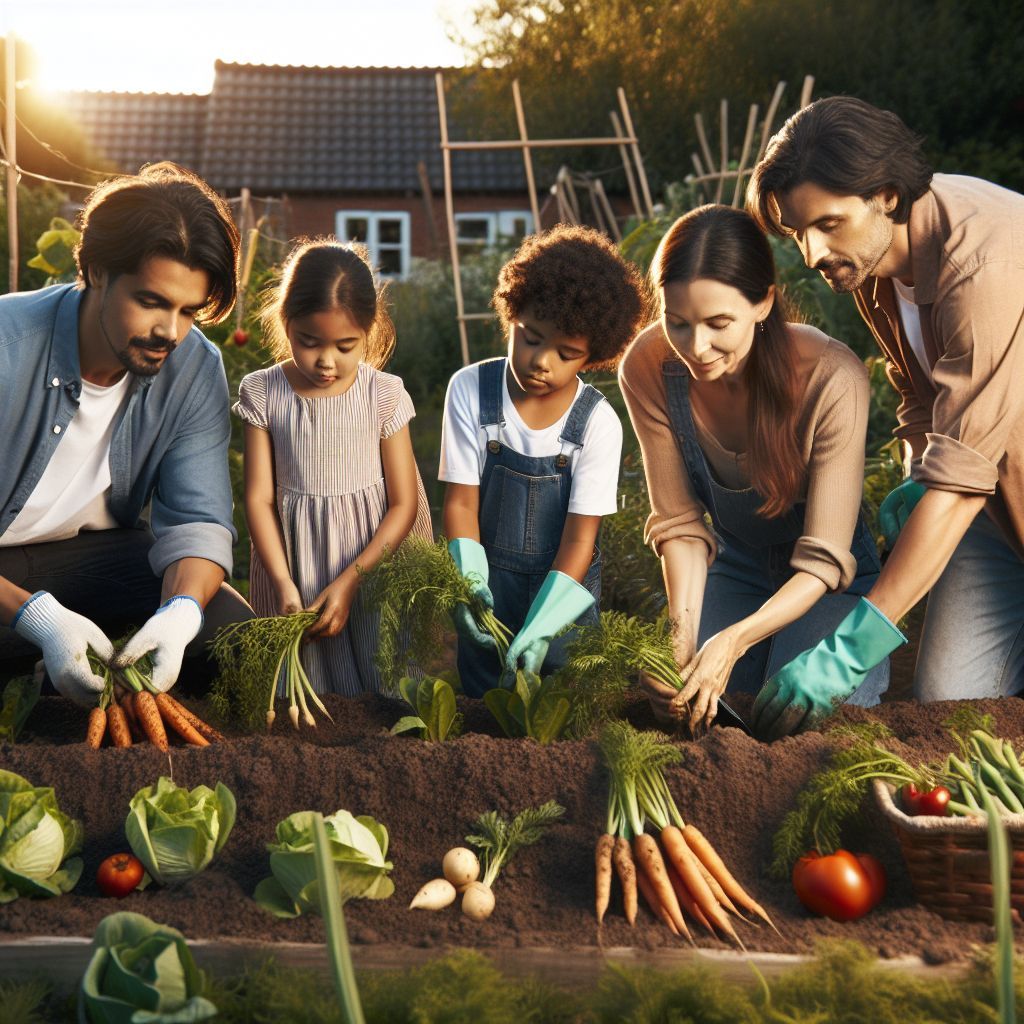
After months of tending to your urban oasis, it’s time to enjoy the fruits of your labor—literally. Harvesting at the right time ensures the best flavor and nutrient content. And when you have more than you can eat, preserving your produce allows you to savor the taste of summer even in the coldest months.
When and How to Harvest for Peak Freshness
Harvesting is all about timing. Most vegetables are best picked in the morning when they’re still cool. Leafy greens should be snipped when tender, tomatoes when they’re just the right shade of red, and herbs before they flower for the most intense flavor.
Example: “By harvesting my herbs in the early morning, I ensure they’re bursting with flavor. My basil pesto has never tasted better!”
Understanding the signs of peak ripeness will make all the difference.
Preservation Methods: From Canning to Freezing
When you’ve got a surplus, preservation is key. Canning, drying, and freezing are all effective methods to extend the shelf life of your harvest. Tomatoes can be turned into sauces and canned, herbs dried for winter use, and berries frozen to add a splash of summer to your smoothies year-round.
Aiding Local Food Systems
Urban homesteading does more than just beautify your space; it’s a powerful tool for enhancing local food systems. By growing your own, you reduce dependence on distant farms and contribute to food security in your community. It’s a ripple effect—each urban garden can inspire another, creating a network of sustainable food sources.
Urban Homesteading’s Impact on Food Security
Food security is a pressing issue in many urban areas. By producing your own food, you’re taking an active role in solving this problem. Plus, any excess can be donated to local food banks, making fresh, nutritious produce more accessible to those in need.
Partnering with Local Markets and Food Banks
Building relationships with local markets and food banks can amplify your impact. These partnerships allow you to share your harvest with the community, supporting those who may not have access to fresh food. It’s a win-win—you get to help others while ensuring nothing goes to waste.
Selecting the Right Tools and Supplies
Now, let’s gear up. The right tools can make a world of difference in your gardening experience. You don’t need a shed full of equipment—just a few quality essentials. A sturdy trowel, pruning shears, gloves, and a watering can are must-haves. And when it comes to seeds, opt for non-GMO and heirloom varieties for the healthiest and most flavorful crops.
By now, you might be wondering where to find these non-GMO heirloom seeds and quality tools. Well, look no further. Survival Essentials offers a curated selection of non-GMO heirloom seeds that are perfect for your urban homestead. From vegetables to fruits, their collection can help you grow a vibrant and diverse garden.
Ready to take the next step in your urban homesteading journey? Check out Survival Essentials’ collection and start planning your garden today. With their wide range of products, you’ll have everything you need to turn your city space into a thriving food haven. For more guidance on growing your own food in a city, explore these practical tips.
Essential Equipment for Starting an Urban Homestead
Before diving into urban homesteading, let’s talk gear. You’ll need a solid trowel for planting, durable gloves for protection, a watering can for hydration, and quality pruning shears for upkeep. But don’t forget the most important ingredient: seeds. The right seeds will set the foundation for your garden’s success.
Here’s a tip: invest in a few high-quality tools rather than a bunch of cheap ones. They’ll last longer and make your gardening experience much more enjoyable. And when it comes to seeds, heirloom varieties are the jewels of the garden. They’ve been passed down through generations and are known for their exceptional taste and vigor.
The Environmental Benefits of Choosing Non-GMO and Heirloom Seeds
Opting for non-GMO and heirloom seeds isn’t just a nod to tradition—it’s a commitment to sustainability. These seeds haven’t been modified in a lab and are less dependent on chemical pesticides and fertilizers. This means healthier soil, healthier plants, and a healthier you.
Example: “When I switched to heirloom seeds, not only did I notice a remarkable improvement in the taste of my vegetables, but I also saw a resurgence of beneficial insects in my garden.”
By choosing these seeds, you’re helping to preserve biodiversity and protect our agricultural heritage. And the flavors are unbeatable—just wait until you bite into a tomato that tastes like sunshine.
Heirloom seeds are a connection to our past and a pathway to a sustainable future. They’re more than just seeds; they’re living history. And the best part? They often produce vegetables that are more resilient and adaptable to your unique urban microclimate.
Final Thoughts: The Future of City Farming
Urban homesteading is not just a trend; it’s a movement. It’s about reclaiming our connection to the food we eat and taking responsibility for our part in the ecosystem. With every seed planted, we’re making a statement: we care about our health, our communities, and our planet.
The future of city farming looks bright, with innovative solutions like vertical gardens and hydroponics opening up even more possibilities. It’s an exciting time to be an urban homesteader. So roll up your sleeves, get planting, and join the revolution of green thumbs making a real difference.
Frequently Asked Questions (FAQ)
You’ve got questions; I’ve got answers. Let’s dig into some common queries about urban homesteading.
Is Urban Homesteading Expensive to Start?
It’s a common myth that you need a lot of money to start homesteading. Not true! With some creativity and resourcefulness, you can start small and scale up. Remember, it’s about using what you have effectively.
Costs can vary, but here’s a basic breakdown:
A packet of heirloom seeds can cost between $2 and $5.
Basic gardening tools might set you back around $30 to $50.
Containers and soil can range from $10 to $100, depending on size and quality.
Of course, these are just estimates. You can also save money by using recycled containers or by making your own compost.
Can I Homestead if I Only Have Indoor Space?
Absolutely! Urban homesteading isn’t limited to those with yards. Windowsills, balconies, and even walls can be transformed into productive spaces. Indoor container gardens, hanging planters, and hydroponic systems are great ways to grow food indoors.
What Are Heirloom Seeds and Why Should I Use Them?
Heirloom seeds are varieties that have been passed down through generations without genetic modification. They’re cherished for their flavor, nutritional value, and adaptability to local conditions. Using them supports genetic diversity and gives you a taste of the best nature has to offer.
Heirloom seeds are the guardians of our agricultural diversity. By planting them, you’re participating in a tradition that goes back centuries.
Plus, heirloom plants often have unique stories and histories, adding a layer of richness to your gardening experience.
How Can I Maximize Crop Yield in a Small Area?
Maximizing crop yield in a small space is all about smart planning. Here’s how:
Choose high-yield crops like tomatoes, peppers, and leafy greens.
Practice succession planting to keep your garden producing continuously.
Use vertical space with trellises and hanging planters to grow more.
With these strategies, you’ll be amazed at how much you can harvest from even the tiniest spaces. Discover more on urban gardening to enhance your food production.
How Does Urban Homesteading Benefit the Environment?
Urban homesteading transforms concrete jungles into lush, green landscapes. It reduces the carbon footprint associated with transporting food, supports pollinators by providing habitats, and helps manage rainwater runoff. Plus, it’s a hands-on way to teach others about sustainability.
Every urban garden is a step toward a greener, more sustainable future. It’s about making an impact, one plant at a time.
And there you have it—the blueprint for starting your urban homesteading adventure. Remember, it’s about progress, not perfection. So, embrace the journey, learn as you go, and enjoy the satisfaction of growing your own food. Happy homesteading!




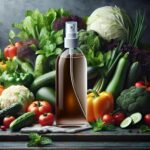
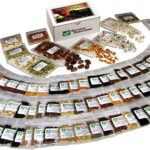

Leave a Reply